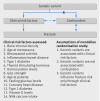Assessment of the genetic and clinical determinants of fracture risk: genome wide association and mendelian randomisation study
- PMID: 30158200
- PMCID: PMC6113773
- DOI: 10.1136/bmj.k3225
Assessment of the genetic and clinical determinants of fracture risk: genome wide association and mendelian randomisation study
Abstract
Objectives: To identify the genetic determinants of fracture risk and assess the role of 15 clinical risk factors on osteoporotic fracture risk.
Design: Meta-analysis of genome wide association studies (GWAS) and a two-sample mendelian randomisation approach.
Setting: 25 cohorts from Europe, United States, east Asia, and Australia with genome wide genotyping and fracture data.
Participants: A discovery set of 37 857 fracture cases and 227 116 controls; with replication in up to 147 200 fracture cases and 150 085 controls. Fracture cases were defined as individuals (>18 years old) who had fractures at any skeletal site confirmed by medical, radiological, or questionnaire reports. Instrumental variable analyses were performed to estimate effects of 15 selected clinical risk factors for fracture in a two-sample mendelian randomisation framework, using the largest previously published GWAS meta-analysis of each risk factor.
Results: Of 15 fracture associated loci identified, all were also associated with bone mineral density and mapped to genes clustering in pathways known to be critical to bone biology (eg, SOST, WNT16, and ESR1) or novel pathways (FAM210A, GRB10, and ETS2). Mendelian randomisation analyses showed a clear effect of bone mineral density on fracture risk. One standard deviation decrease in genetically determined bone mineral density of the femoral neck was associated with a 55% increase in fracture risk (odds ratio 1.55 (95% confidence interval 1.48 to 1.63; P=1.5×10-68). Hand grip strength was inversely associated with fracture risk, but this result was not significant after multiple testing correction. The remaining clinical risk factors (including vitamin D levels) showed no evidence for an effect on fracture.
Conclusions: This large scale GWAS meta-analysis for fracture identified 15 genetic determinants of fracture, all of which also influenced bone mineral density. Among the clinical risk factors for fracture assessed, only bone mineral density showed a major causal effect on fracture. Genetic predisposition to lower levels of vitamin D and estimated calcium intake from dairy sources were not associated with fracture risk.
Published by the BMJ Publishing Group Limited. For permission to use (where not already granted under a licence) please go to http://group.bmj.com/group/rights-licensing/permissions.
Conflict of interest statement
Competing interests: All authors have completed the ICMJE uniform disclosure form at www.icmje.org/coi_disclosure.pdf and declare: support from the organisations listed in the funding statement for the submitted work; BMP serves on the data safety monitoring board of a clinical trial funded by the manufacturer (Zoll LifeCor) and on the Steering Committee of the Yale Open Data Access Project funded by Johnson and Johnson; CEE is currently employed by AstraZeneca; SR has received grants from Eli Lilly, Amgen, UCB, and Ultragenyx, and has provided consultation for Novartis; KE is currently employed by Biogen; US, UT, GT, and KSt are employed by deCODE genetics/Amgen; and AK, JYT, and DAH are employed by 23andMe, and hold stock or stock options in 23andMe.
Figures



References
-
- Melorose J, Perroy R, Careas S. World population prospects. United Nations, 2015, 10.1017/CBO9781107415324.004. - DOI
-
- Cooper C, Melton LJ. Magnitude and impact of osteoporosis and fractures. Academic Press, 1996.
Publication types
MeSH terms
Grants and funding
- R01 AG023629/AG/NIA NIH HHS/United States
- UL1 RR024140/RR/NCRR NIH HHS/United States
- 110141/Z/15/Z/WT_/Wellcome Trust/United Kingdom
- R01 AR035582/AR/NIAMS NIH HHS/United States
- G9800062/MRC_/Medical Research Council/United Kingdom
- N01HC85081/HL/NHLBI NIH HHS/United States
- UL1 TR001881/TR/NCATS NIH HHS/United States
- R01 AG027574/AG/NIA NIH HHS/United States
- U01 AR045614/AR/NIAMS NIH HHS/United States
- R01 AR050066/AR/NIAMS NIH HHS/United States
- T32 AG000186/AG/NIA NIH HHS/United States
- N01HC85080/HL/NHLBI NIH HHS/United States
- U01 AR045583/AR/NIAMS NIH HHS/United States
- UL1 TR000124/TR/NCATS NIH HHS/United States
- N01 AG062103/AG/NIA NIH HHS/United States
- P01 AG005842/AG/NIA NIH HHS/United States
- R01 AR035583/AR/NIAMS NIH HHS/United States
- U01 HL080295/HL/NHLBI NIH HHS/United States
- N01 HC085079/HC/NHLBI NIH HHS/United States
- R01 HL120393/HL/NHLBI NIH HHS/United States
- P30 AG012810/AG/NIA NIH HHS/United States
- MR/N003284/1/MRC_/Medical Research Council/United Kingdom
- G0800582/MRC_/Medical Research Council/United Kingdom
- U01 HL130114/HL/NHLBI NIH HHS/United States
- R01 HL103612/HL/NHLBI NIH HHS/United States
- N01 AG062106/AG/NIA NIH HHS/United States
- U01 AG018197/AG/NIA NIH HHS/United States
- MC_U147585819/MRC_/Medical Research Council/United Kingdom
- G1000143/MRC_/Medical Research Council/United Kingdom
- R01 AG027576/AG/NIA NIH HHS/United States
- R01 AR072199/AR/NIAMS NIH HHS/United States
- N01HC85082/HL/NHLBI NIH HHS/United States
- R01 AR041398/AR/NIAMS NIH HHS/United States
- U01 AR045647/AR/NIAMS NIH HHS/United States
- U01 AR045632/AR/NIAMS NIH HHS/United States
- R01 HL105756/HL/NHLBI NIH HHS/United States
- MC_UP_A620_1014/MRC_/Medical Research Council/United Kingdom
- N01AG12100/AG/NIA NIH HHS/United States
- R01 AR035584/AR/NIAMS NIH HHS/United States
- N01HC55222/HL/NHLBI NIH HHS/United States
- P30 DK063491/DK/NIDDK NIH HHS/United States
- R01 AG032098/AG/NIA NIH HHS/United States
- U01 AR045654/AR/NIAMS NIH HHS/United States
- N01HC85083/HL/NHLBI NIH HHS/United States
- 14136/CRUK_/Cancer Research UK/United Kingdom
- R01 AG026720/AG/NIA NIH HHS/United States
- N01HC85086/HL/NHLBI NIH HHS/United States
- G0401527/MRC_/Medical Research Council/United Kingdom
- N01 AG062101/AG/NIA NIH HHS/United States
- MC_UU_12013/4/MRC_/Medical Research Council/United Kingdom
- U01 AG027810/AG/NIA NIH HHS/United States
- U24 AG051129/AG/NIA NIH HHS/United States
- U01 AR045580/AR/NIAMS NIH HHS/United States
- MR/M004422/1/MRC_/Medical Research Council/United Kingdom
- MC_UU_12011/1/MRC_/Medical Research Council/United Kingdom
- R01 AG005394/AG/NIA NIH HHS/United States
- R01 AG005407/AG/NIA NIH HHS/United States
- R01 HL087652/HL/NHLBI NIH HHS/United States
LinkOut - more resources
Full Text Sources
Other Literature Sources
Medical
Miscellaneous
